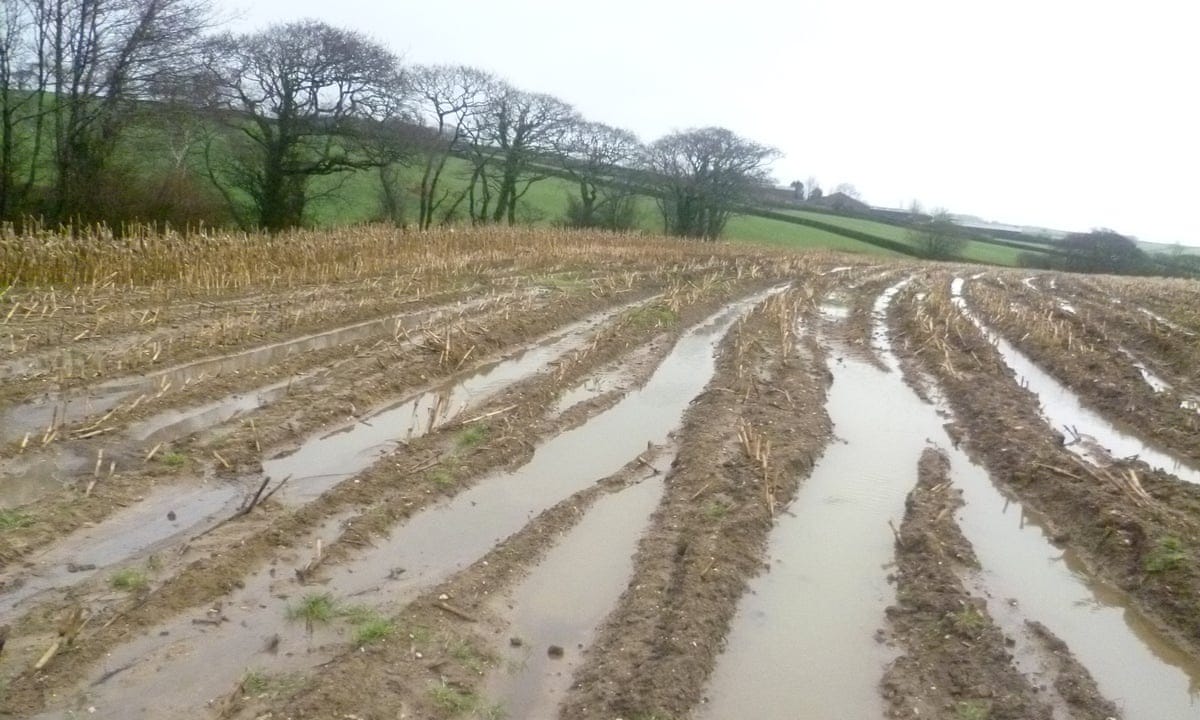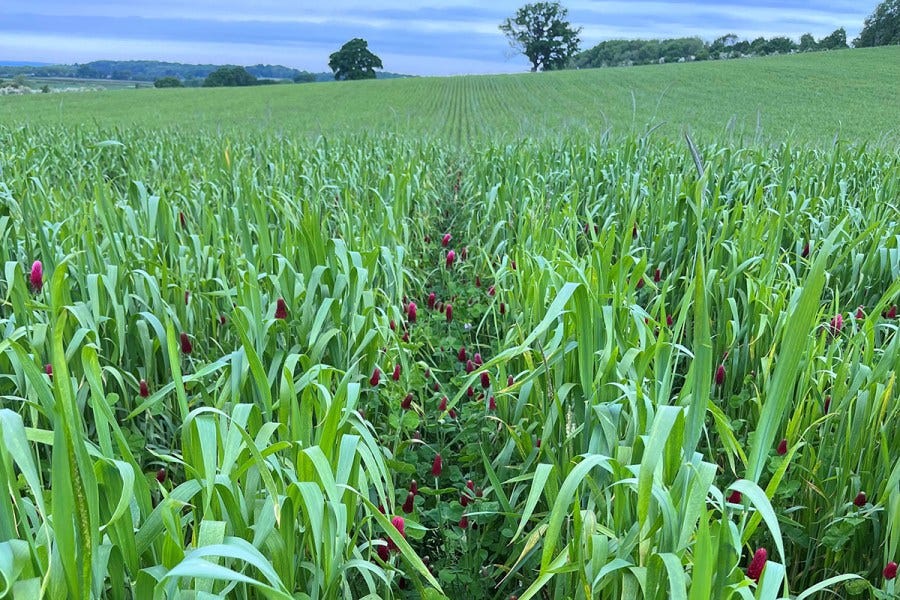A Ramble on Soil and Sustainable Farming
Unsustainable farming practises, the beginnings of soil and Wildfarmed
Hi readers,
How much do you understand soil and sustainable farming?
I hope this newsletter will be eye opening and informative, yet I must apologise in advance as this is a heavy read!
Soil is important to me and keeps me employed, in fact, you could say soil is my manager. If we didn’t have soil, I wouldn’t have any gardens to work in and so forth.
I’m trialing something new and if you’d like to listen, rather than read - you can below:
Do you know how the soil evolved?
Around 4.5 billion years ago, rocks began to break down and erode due to physical, chemical and biological weathering. Physical being temperature changes, chemical being the rain and biological being life forms developing. When the first plants began to grow and die (bacteria, algae, and cyanobacterium), they rotted down, beginning the formation of the first ever organic matter, aka, the soil.
Soil has always been here, we see it everyday, it is beneath us everywhere we walk and the home for many critters and creatures, as well as the perfect growing medium for trees and plants.
For a brief period of my life, I was a horticultural lecturer, teaching the RHS level 2 syllabus. During this time, I was reminded of the world’s apple metaphor to demonstrate how little soil we have available for growing.
Skip to 0.32 of this video:
What part does farming play in soil?
When crops are grown around the world, they are typically grown as monocultures, a single crop species growing in one field. We have all been in the car and passed by fields of sweet corn or wheat and marvelled.
If you take a walk over some fallow farm land, notice if you see the same weeds growing across the soil….
If the same weed species dominates, it tells you that specific soil conditions, like poor drainage, compaction, or lack of nutrients are the same over the entire field.
Unsustainable farming practises
I have broken down the step-by-step processes most unsustainable UK farmers follow when growing crops, from field preparation to harvesting:
1 - Field Preparation – Some farms first clear the land using herbicides or burning crop residue before ploughing.
2 - Ploughing (Primary Tillage) – Large tractors with ploughs turn the soil over, breaking up compacted areas (but actually causing deeper compaction and poor drainage over time).

3 - Tilling (Secondary Tillage) – Using rototillers or ploughs to further break up the soil, mix in organic matter, and prepare a finer seedbed (again, disrupting soil structure and beneficial organisms).
4 - Disking – Breaking up clumps of soil, cutting crop residue, and smoothing the field before planting (this step is more common in heavy soils).
5 - Soil pH Testing & Amendments – Excessive fertilisers can make soil too acidic or alkaline. Farmers check pH and apply lime (to reduce acidity) or sulphur (to lower alkalinity).
6 - Fertiliser Application – A mix of NPK (Nitrogen, Phosphorus, Potassium) is added to promote growth.
7- Herbicides & Pesticides – Applied before planting to kill weeds and prevent pest infestations.
8 - Seed Drilling or Broadcast Seeding – Seeds are planted using machinery (drilled in rows for most crops, scattered for wheat/grass).
9 - Additional Fertiliser Application – More fertiliser is added during early growth to boost crop yield.
10 - Pesticide, Herbicide & Fungicide Spraying – Farmers spray multiple times throughout the season to control weeds, pests, and diseases.
11 - Irrigation (if required) – While most UK farms rely on rainfall, some fields need additional watering and regular crop monitoring & maintenance, checking for disease, nutrient deficiencies, or pests before deciding on additional chemical applications.
12 - Harvesting – Crops are harvested using combine harvesters or other machinery.
So you can see there is no process which feeds the soil, instead the crops are fed. The soil is alive, full of bacteria and the home for many beneficial insects and fungi - however if they aren’t fed, why would they stick around?
A lot of the time, these organisms will be poisoned by pesticides, herbicides and fungicides, as well as excessive fertiliser use.
So why do farmers grow like this?
To maximise yield & profit in a competitive market
Some UK farmers grow crops under contract farming agreements, meaning they must meet strict production targets set by buyers (an example: McDonald’s for potatoes, breweries for barley) therefore, high yield and profit are favoured in a competitive market.
To meet supermarket & contract demands
Supermarkets have strict size, shape, and quality standards for crops like wheat, potatoes, and vegetables so farmers rely on fertilisers, pesticides, and intensive tilling to ensure consistent production.
To cope with government regulations & subsidy changes
The UK government & the post-Brexit farm payment system known as Environmental Land Management Schemes - ELMS have a big part to paly. After leaving the EU, the UK introduced its own payment system called ELMS - instead of paying farmers for owning land, instead the farmers can receive financial support if they improve soil health, protect wildlife and biodiversity, reduce carbon emissions, prevent flooding and water pollution.
This is all well and good, however many farmers worry that these changes will hurt short-term profitability. It seems the transition to ELMS has been slow and confusing, with delays in payments and uncertainty about how much farmers will actually receive. So, if these farmers reduce their yields to focus on environmental practices, they would risk losing income unless ELMS payments fully cover the difference.
To stay competitive with global imports
The UK imports a significant portion of its food - local farmers must compete with cheaper imports from countries like the USA, Brazil, and Europe. Take a look at the packet before you buy anything in the supermarket and you’ll understand what farmers are up against. Therefore, to stay competitive, farmers increase production through intensive farming.
To manage unpredictable weather & soil conditions
UK weather is unpredictable (rain, droughts, late frosts), so farmers use chemical inputs and mechanisation to reduce risks.
The Silver Lining - Sustainable Farming and Food Systems
Let’s discuss Wildfarmed!
Do you know Groove Armada? Well, hero Andy Cato, began to learn about the detrimental effects of industrial agriculture. He sold his music rights and purchased a farm in France, where he continues to work on developing sustainable farming methods, founded in 2018.
He has completed changed the mindset behind farming, and many other farmers are beginning to move over to sustainable ways of growing, due to government incentives.
A very interesting watch:
Their main focus is to respect and feed the soil (growing mostly wheat) so here are some of the factors they work with:
No heavy machinery!
Cover crops - like clover or vetch are grown and used to enrich the soil once they have gone over.
Organic matter, such as manure used as fertiliser, rather than synthetic fertilisers.
Crop Rotation, growing different crops in each field every year. Ex: beans are nitrogen fixers and if you leave the roots in the soil, they will provide nutriens for the next crop planted.
Intercropping - multiple crops are planted at the same time, however these grown to different heights:
Tall crops like wheat or barley are planted alongside shorter crops like legumes (e.g., clover, peas).
The wheat provides a canopy that offers some shade, while legumes add nitrogen to the soil.

Diversity in planting - the combination of crops like wheat, legumes, and grasses in the same field maximises land use and creates a diverse ecosystem that encourages natural pest control and healthy plant growth.
Grazing Livestock - Cows, sheep, and other livestock roam the fields, grazing on fallow land, crop residue, and cover crops. Their waste fertilises the soil naturally with manure, they control weeds by grazing unwanted vegetation and maintain soil health by helping with soil aeration and encouraging nutrient cycling. Yet, they rotate the animals to ensure no field is overgrazed and to allow land to rest and recover
Integrated pest management (IPM) methods are preferred, relying on natural predators and careful observation to control pests.
Specific machinery - An inter-row mower is designed to manage crops between rows of cereal, avoiding competitive growth.
Wildfarmed Economic Model
Wildfarmed produces crops using regenerative, environmentally friendly methods and therefore, premium prices have to be charged. Consumers must be willing to pay more for food, so Wildfarmed is keen to educate so the buyer is able to understand why they have to pay an additional £1.50 for their bread, to encourage a sustainable food system.
Fresh fruit and vegetables are SO cheap, however when you choose to buy organic, the cost increases considerably. Organic farmers have lower yields of crops, more intensive labour, and a limited scale of production to keep within the organic standards. This standard is set by Soil Association / DEFRA in the UK, involving fees and regular inspections, which add to the overall cost of production.
How can you care for you soil?
A huge part of my job is managing the soil. When I take on a new client, a priority is to getting the soil quality up to scratch, fixed over a period of years by adding well-rotted manure.
So I always say more manure - add a thick layer of well sourced, well rotted manure to your soil every year and you’ll invite an abundance of biodiversity into your garden!
Hope you enjoyed reading and thank you <3 !














I just mulched the beds and pots in my little garden on the pontoon with well-rotted manure to set it up for happiness in the months to come but wondering who’s going to take over the job after I leave 😫 thank you for writing this Sarah! Incredibly nerdy but a very important topic!!
I need to start this in my garden thanks for the advice.